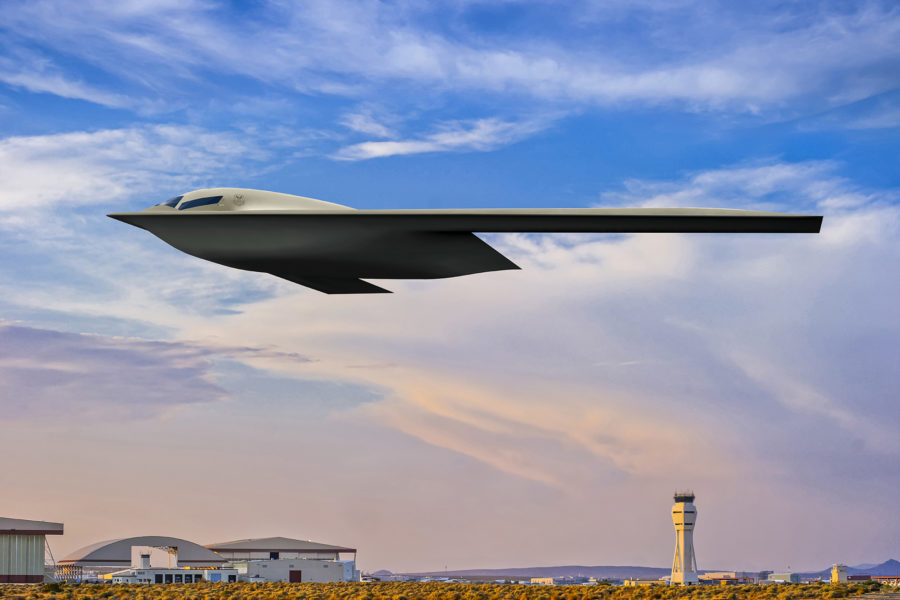Some facilities supporting the first B-21 Raider unit at Ellsworth Air Force Base, S.D., are to be ready by 2024, according to Air Force budget request documents, indicating the service anticipates a swift test and evaluation program for the new aircraft.
The Air Force announced last year that Ellsworth is to be the initial B-21 operating base and the formal training unit, or “schoolhouse,” for the bomber. The base now hosts the B-1B Lancer.
According to justifications (the so-called “J-Books”) in the Air Force’s fiscal 2023 budget, just released, three military construction projects at Ellsworth are requested for a collective $328 million, including a Low Observables Restoration Facility, a Weapons Generation Facility, and a Radio Frequency Facility.
The two-bay LO restoration facility, which is to be climate-controlled and have filtration gear to support spray-on stealth treatments, is to be finished by September 2024, according to the documents. The weapons generating facility—which will assemble bombs and missiles and get them ready to be loaded onto aircraft—is to be complete by February 2026. No completion date was given for the Radio Frequency Facility, which will test the B-21’s stealth prior to missions.
The Air Force has maintained since the B-21 program began that the program would yield at least one “usable asset” by the “mid-2020s.” Lt. Gen. James C. Dawkins, deputy chief of staff for strategic deterrence and nuclear integration, said last year that the B-21 will be available for missions “around 2026 or 2027.”
At least six B-21s are in some stage of construction, said Randy Walden, Rapid Capabilities Office director. Last year, Walden predicted that the first B-21 would roll out and fly in “mid-2022,” although in March of this year he declined to be more specific, saying only that the rollout will be event-driven, not calendar-driven.
The first B-21 is undergoing calibration tests and will soon need to be moved outside Northrop Grumman’s Palmdale, Calif., production plant for engine runs and taxi tests prior to first flight, Walden reported. There was a public rollout for the B-2 Spirit bomber in 1988 ahead of such outdoor pre-flight testing. Walden said he expected a similar ceremony for the B-21, as the beginning of powered tests will be a “historical event.” After slow- and high-speed taxi tests, the B-21 will make its first flight, likely to be a short hop to nearby Edwards Air Force Base, Calif.
Having some of the Ellsworth facilities ready in 2024 suggests an aggressive program for flight testing the B-21. The B-2 was tested for four years between 1989 and 1993, when the first operational example was delivered to Whiteman Air Force Base, Mo., the sole B-2 operating base and schoolhouse.
Air Force leaders have emphasized in recent months that the B-21 is the centerpiece of a strategic “family of systems” that will include uncrewed escort aircraft providing sensory data, suppressing air defenses, providing communications links, and conducting electronic warfare, among other tasks. The B-21 itself was intended from the beginning of the program to be an “optionally manned” platform and capable of deploying either conventional or nuclear weapons. Besides direct-attack weapons, the B-21 is to be capable of employing stand-off missiles such as the Long-Range Standoff weapon, or LRSO. It was also designed from the outset with an “open architecture” to reduce integration risk and allow competition for future upgrades.
The Air Force plans to acquire “at least” 100 B-21s, but comments from senior leaders in recent years indicate the service is leaning toward a buy of 145 or more.
After Ellsworth, the “preferred locations” for B-21 basing include Whiteman and Dyess Air Force Base, Texas, which now operate the B-2 and B-1B, respectively. The Air Force has said it expects to retire the B-2 circa 2031 and the last B-1Bs around 2032. The B-21 depot is to be at Tinker Air Force Base, Okla.
The Air Force is also asking for $30 million to acquire acreage adjacent to the air logistics center at Tinker to house B-21 depot activities. The Air Force envisions a 133-acre campus with “21 docks and environmental shelters with associated facilities and infrastructure.” The docks will handle maintenance, “de-paint, wash, fuel, radio frequency diagnostic, and parts storage” for the Raider. The facilities will be built “in phases.” The Air Force would add 80 acres to the 53 acres it already has in the vicinity to create the campus. Consolidating all these activities in a single place will save $500 million over the life of the B-21 program, the Air Force said, and it needs to acquire the land by the end of fiscal 2023 to have the depot available when needed.
